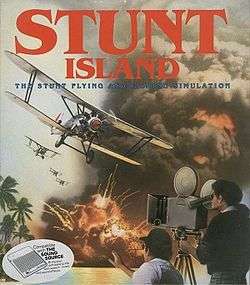Stunt Island
| Stunt Island | |
|---|---|
 | |
| Developer(s) | The Assembly Line |
| Publisher(s) | Disney Interactive |
| Designer(s) |
Ronald J. Fortier Adrian Stephens |
| Platform(s) | MS-DOS |
| Release | |
| Genre(s) | Flight simulator |
| Mode(s) | Single-player |
Stunt Island is a flight simulation video game for MS-DOS PCs released in 1992. It was designed by Adrian Stephens and Ronald J. Fortier and published by Disney Interactive. The game, marketed as "The Stunt Flying and Filming Simulation", provides an island which contains a number of different film sets, such as a city, an oil rig, a canyon, and an aircraft carrier. The player can position cameras and props around these sets, and create triggers to start actions including the camera panning and an object moving. The game also has an editing mode where the player can splice together taped footage and insert sound effects.
Game components
Game engine
The game engine for Stunt Island was co-developed by The Assembly Line. It is capable of simultaneously rendering several hundred simple 3D objects on a typical early 1990s PC with 386 processor at 33 MHz with two megabytes of RAM.
The graphics of the game are rendered in 256 colors at 320x200 resolution and the airplanes are shaded using Gouraud shading.
Stunt coordinator
When a player does not wish to create a stunt from scratch, he or she may go to the Stunt Coordinator on Stunt Island. The Stunt Coordinator possesses a built-in list of 32 stunt scenes. If the player is participating in the optional Stunt Pilot of the Year competition, these stunts must be completed to improve ranking.
Set design
In set design, a player may place props, cameras, and collideable triggers. Conditional and timed events may also be created to perform particular actions.
Flight simulator
While actually filming a stunt, the player's controls are that of a flight simulator. There is an airfield in the game where the player can select a plane and fly around Stunt Island to scout different locations.
Editing room
In the editing room the player is able to take previously recorded footage and splice them together into a single movie. Sound effects and music may also be added.
Theater
Movies may be watched in this room. Such movies may come with the game, be created by the player, or be downloaded from the Internet. The game also comes with a tool called MAKEONE which may be used to generate a self-contained version of a movie, which may be played on a machine without the game by using the PLAYONE tool.
Community history
Soon after the release of Stunt Island in 1992, there was a large amount of activity related to the game in the Flight Simulation Forum on CompuServe. Users of the software posted films they created onto CompuServe, where they could be downloaded and watched by other users.
Since 1999, Stunt Island activity has centered on the SIFA Yahoo! Group
Reception
Computer Gaming World in 1993 praised Stunt Island's graphics, ease of use, editing features, and variety of aircraft, concluding that "it represents the future of simulation products [and] also a step toward a future where films can be created completely on the microcomputer".[2] That year the magazine gave it a Special Award for Innovation, and nominated it for Simulation Game of the Year.[3] The game also received a Critics Choice Award for Best Consumer Product from the Software Publishing Association,[4] and was nominated for an award at the 1993 Game Developers Conference.[5]
In 1994, PC Gamer UK named Stunt Island the 45th best computer game of all time. The editors wrote, "A great little package, but as with many 'games' of this type, its rewards are only visible if you're willing to invest time and effort. We strongly recommend you do just that."[6]
See also
References
- ↑ Stunt Island at GameFAQs
- ↑ Trimble, Timothy L. (March 1993). "Stunt Island - A Star Is Made!". Computer Gaming World. p. 78. Retrieved 6 July 2014.
- ↑ "Computer Gaming World's Game of the Year Awards". Computer Gaming World. October 1993. pp. 70–74. Retrieved 25 March 2016.
- ↑ "Awards - Thy Name Is Controversy". Computer Gaming World. May 1993. p. 146. Retrieved 7 July 2014.
- ↑ "The 7th International Computer Game Developers Conference". Computer Gaming World. July 1993. p. 34. Retrieved 12 July 2014.
- ↑ Staff (April 1994). "The PC Gamer Top 50 PC Games of All Time". PC Gamer UK (5): 43–56.
External links
- Stunt Island Harbor
- Stunt Island Filmmaker's Association (Yahoo! Group)
- File archive of Stunt Island films and other material
- Information on Stunt Island Editor Program
- Stunt Island at MobyGames